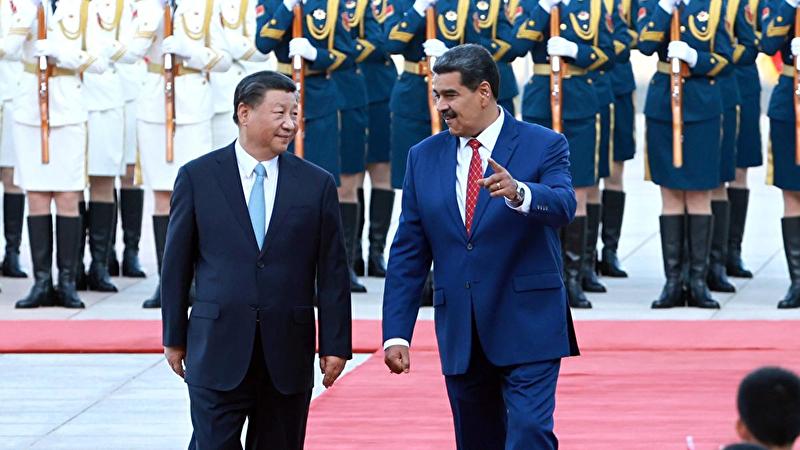In a bold move that reshapes Latin America’s energy dynamics, China Concord Resources Corp (CCRC) has deployed a $1 billion floating oil facility in Lake Maracaibo, western Venezuela. The project, a 20-year production-sharing agreement with Venezuela’s state oil company PDVSA, aims to pump 60,000 barrels per day (bpd) by late 2026—up from the current 12,000 bpd.
While the initiative is framed as a commercial venture, its scale and location raise deeper questions: Is China quietly constructing a strategic buffer in Venezuela to secure its energy supply and shield the Maduro regime from Western pressure?
Venezuela Oilfields in Function
At the heart of this initiative is the jackup rig “Alula”, a floating production platform recently positioned in Lake Maracaibo. Once the center of Venezuela’s oil boom, the region has fallen into decay due to sanctions, mismanagement, and divestment. China’s arrival—through CCRC—marks the largest foreign oil services mobilization in Venezuela in over a decade.
CCRC, a private Chinese firm, is now operating the Lago Cinco and Lagunillas Lago fields. Under the 20-year deal, authorized via Venezuela’s Anti-Blockade Law (2020), CCRC will revive up to 500 oil wells, supported by over 60 Chinese technical specialists already on-site.
The plan includes extracting both light and heavy crude, with light oil allocated to PDVSA for domestic use and the heavier grades destined for export—primarily to China.
Strategic Timing: Capitalizing on a Sanctions Vacuum
This oil deal move from China comes as Venezuela remains under U.S. sanctions, which have deterred most Western firms from doing business with Caracas. With international majors sidelined, Chinese firms—particularly private entities like CCRC—have seized the opportunity to fill the vacuum.
According to energy analysts, this isn’t just opportunism. It’s part of a broader “Sino-Venezuelan oil corridor”, where over 90% of Venezuela’s oil exports already go to China. This deepening trade relationship not only boosts Beijing’s energy security but gives Caracas an economic lifeline and political shield.
How the U.S. Is Responding
The U.S. has conducted its largest naval deployment in the Caribbean since the 1989 Panama invasion, including submarines, destroyers, cruisers, and marines to monitor and pressure Maduro’s regime
A U.S. strike on a vessel allegedly tied to Venezuelan narco-terrorist activity resulted in 11 deaths, highlighting increasing U.S. willingness to engage militarily in the region.
China’s Military Hardware Support to Maduro
Beyond pipelines and oilfields, China has been a longstanding supplier of military equipment to Venezuela:
Armored personnel carriers (APCs) such as the VN‑4 “Rhinoceros”, widely used by the National Guard to suppress protests since 2014
Light tanks and APCs, including the VN‑16, VN‑18 amphibious tanks, VN‑1 8×8 APCs, ZBL‑09 APCs, and anti‑riot vehicles delivered over the last decade
Air and naval systems, including K‑8 training jets, Y‑8 transport aircraft, and air defense radars (e.g., JYL‑1, JY‑27A) dating back to the Chávez era.
C‑802A anti-ship cruise missiles, capable of striking ships over 100 nautical miles away
Additional support has come in forms of self‑propelled artillery, rocket launchers, and more advanced vehicles — frequently acquired via oil‑for‑arms arrangements or Chinese credit lines
This equipment not only reinforces the Maduro regime’s internal security apparatus but also gives it enhanced offensive and hybrid warfare capabilities.
Is China Creating a Strategic Buffer in Latin America?
While there’s no formal military component to the CCRC venture, the implications are undeniably geopolitical.
By anchoring infrastructure, personnel, and long-term contracts in western Venezuela, China is building more than just an oil pipeline—it’s establishing economic leverage and strategic insulation. This makes the region significantly more resistant to foreign pressure, particularly from the U.S.
Consider the following factors:
Economic Stakes: A billion-dollar investment gives China strong motivation to protect its assets and supply chains.
Diplomatic Capital: China has already extended massive loans and technology support to Venezuela; this project deepens that interdependence.
Regional Influence: As the U.S. attempts to rebuild ties in Latin America, China’s foothold in Venezuela sends a clear message: Beijing isn’t just an observer—it’s a player.
Although there’s no sign of Chinese military presence or guarantees to “defend” Venezuelan territory, the economic and diplomatic costs of interference have been significantly raised. Any attack or destabilization of these oilfields would not only hurt PDVSA but also damage Chinese interests—making it a potent, if informal, form of deterrence.
The CCRC venture may be billed as a commercial partnership, but its consequences ripple far beyond the oilfields. It bolsters Venezuela’s struggling economy, cements China’s dominance in the country’s energy exports, and places Beijing squarely in the middle of Latin America’s geopolitical equation.
In the absence of bullets or bases, China is deploying barrels—and in doing so, may have quietly built a strategic buffer against Western influence in the Americas.








